New York 1960
Architecture and Urbanism Between the Second World War and the Bicentennial
- 1374bladzijden
- 49 uur lezen
Book by Robert A. M. Stern, Thomas Mellins, David Fishman




Architecture and Urbanism Between the Second World War and the Bicentennial
Book by Robert A. M. Stern, Thomas Mellins, David Fishman
Lviv (also known as Lemberg and L'vov) was the home of one of the oldest and most prominent Jewish communities in Eastern Europe. This guide provides comprehensive descriptions of 235 archival collections related to Jewish history and culture that are held in Lviv archives, libraries, and museums. Most of these rich materials have been unknown to specialists in Jewish studies and have not been examined or utilized in scholarship. The archival holdings that are described in the guide relate to a broad timeframe from the mid-14th century to the early 21st century. They shed light on the Jewish experience in Lviv, the surrounding region of Galicia, other regions of Ukraine, as well as Poland, Belarus, Lithuania, Latvia, and Yugoslavia. The guide is the product of extensive work by a team of researchers, who began their work before the Russian attack on Ukraine and concluded it during the course of the war. An essential reference book for those interested in Jewish and Eastern European history.
Kniha se opírá o rozsáhlý průzkum archivních materiálů a vzpomínek pamětníků a popisuje téměř neuvěřitelnou historii čtyřicítky vězňů z vilenského ghetta, kteří zachránili tisíce vzácných židovských knih a rukopisů před nacisty a později i před sovětskou mocí. Tito lidé, členové „papírové brigády“, byli nuceni třídit uloupené knihy, přičemž nejcennější měly být přepraveny do Ústavu pro výzkum židovské otázky ve Frankfurtu a ostatní posílány jako makulatura. Navzdory hrozbě okamžitého zastřelení však propašovali řadu těch nejcennějších knih zpět do ghetta a ukryli je v podzemních úkrytech. Po osvobození Litvy se ti, kteří přežili, vrátili do Vilna a vykopali ukryté poklady. Brzy však čelili antisemitismu sovětského režimu, jehož představitelem byl Michaíl Suslov. Stali se svědky nového ničení židovských památek a zjistili, že knihy, které zachránili před Němci, je třeba chránit znovu. Tak začalo nové, nebezpečné kolo pašování knih přes hranice Sovětského svazu do Polska, kde však dorazily v době antisemitského násilí a kieleckého pogromu, při němž bylo zavražděno 37 Židů. Knihy tak musely být zachráněny ještě jednou.